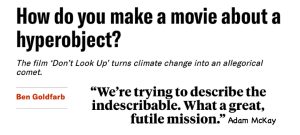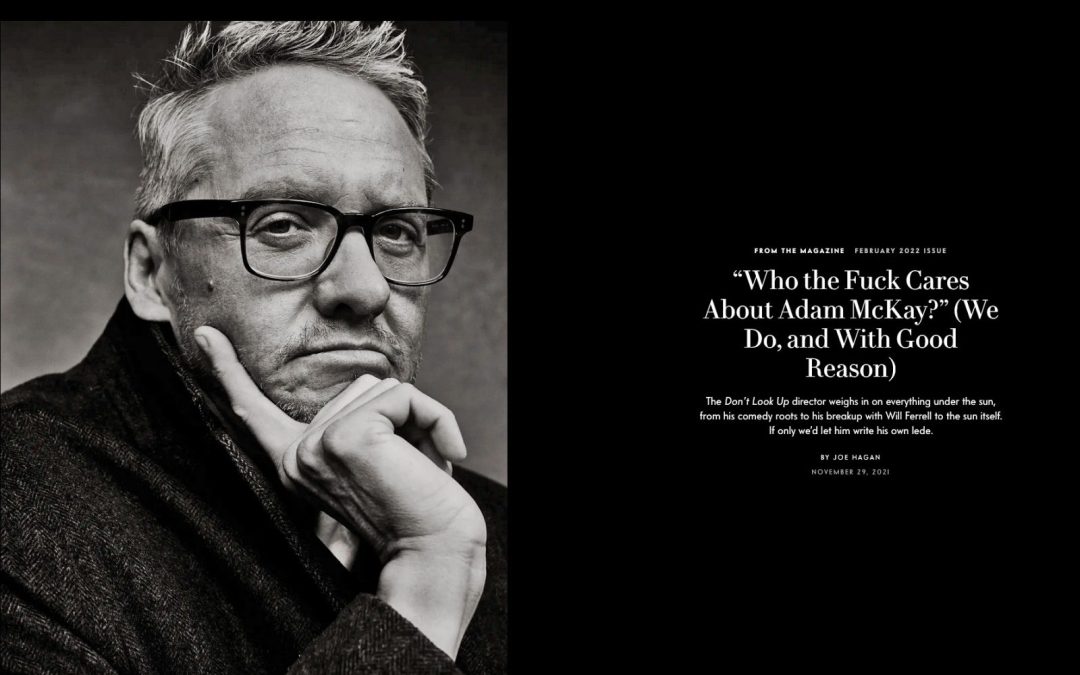
This was the second attempt to get to Adam McKay shortly after his movie Don’t Look Up came out. This particular attempt to Ben Goldfarb occurred in mid-March of 2022. Mr. Goldfarb wrote this article – How do you make a movie about a hyperobject in High Country News in December of 2021, the same month the movie was released.
Here’s Mr. Goldfarb’s response to me with my inquiry below:
Hi Dave, good to hear from you, and interested to learn of your proposed film — sounds like a truly unique project. As a lover of salmonids myself, I’m grateful that there are people like you who’ve devoted their lives to fish conservation. I don’t entirely agree with Joe McGinniss’s assessment that books are dead, though — maybe because I write them myself and have a vested interest in their survival.
Respectfully, I have to decline to share Adam McKay’s contact info. I don’t know him personally, and his information was provided to me in confidence. It’s simply not my place to connect him with others.
Best of luck with your project and I hope you find the right venue for this important story.
Best fishes, Ben
My inquiry letter to Mr. Goldfarb
Hello Ben,
I’m a fish biologist living in remote Alaska – a little village called Aniak that has less than 600-residents. Aniak is 300-miles due west of Anchorage, and the only way to get here is to fly. Consequently, my ability to network is pretty limited…especially, since I’m hoping to connect with someone in Hollywood who might be interested in hearing about a vision I have for a game-changing environmentally-minded movie…and, not a documentary.
I’m hoping that you might be able to help me with that by connecting me with Adam McKay. Please note, I’m not in this endeavor for me. I’m not in it for fame or fortune. My efforts are strictly for the critters and future generations who have no voice, yet will suffer needlessly if we humans don’t get our act together before it’s too late…which, horrifyingly – it might already be.
I read your article in HCN titled How do you make a movie about a hyperobject? I’ve been futilely trying to describe the indescribable for roughly twenty-five years. Initially, I tried writing a book that would do that, one that was predominantly about the burgeoning fish concerns and other exigent environmental issues (e.g., the ever-accelerating loss of biological diversity). Even though this was long before I ever heard of Daniel Quinn and his book Ishmael, my plan was to write it from a fish’s perspective. That failed effort was before climate change was on most people’s radar…including, my own. Needless to say, the myriad environmental conundrums will soon synergize and totally spiral out of control.
My book would have taken a critical and irreverent look at Homo sapiens – which, maybe you know, means “the wise ones”. Is that not the biggest misnomer you ever heard of! Unfortunately, that book effort went nowhere because I don’t possess a penchant for prose. Contrary to what some friends think, I’m the world’s biggest optimist…but, I’m also a realist – a best-selling book was nothing but a huge pipe dream and waste of effort.
Why a film?
The challenge before those of us who are trying to get an effectual environmental message out is only more daunting given today’s political climate and ubiquitous distractions flummoxing the average person…and then there are dreadful circumstances like those facing Ukraine. Adam McKay wasn’t wrong when he said, “What a great, futile mission.”
Being a writer, you may disagree with the following advice I got from Joe McGinniss – author of Going to Extremes when I asked him for help with that book several years ago before he passed away. I knew I needed guidance with the effort, so I naively wrote to many successful authors with the hope of finding assistance. Here’s one correspondence I received from Mr. McGinniss: Given the sorry state of publishing today, I see no possibility of getting a contract that would let me work with you on this.
I regret that, because I’d like to. But if I presented a proposal today for what became Going to Extremes, I wouldn’t even be rejected – I’d be ignored. Likewise, a proposal for a book about “fishes and the environment.”
Reading is on the way out. The visual image is replacing the written word as the basic unit of communication.
Let me put it this way, and I mean no disrespect: in the current publishing environment (and it will only worsen, not improve), even I can’t get a book deal. That’s after twelve books, six of which were NY Times best-sellers.
I’m rooting for you, but there’s no way I can help you.
I would advise you to apply your considerable and valuable energies elsewhere.
And I wish you the best,
Joe
Long before that, I often wondered if Rachel Carson were alive today, would she have anywhere near the influence she did when she wrote Silent Spring over a half century ago? Optimism aside, I’m inclined to think not.
My energies are now focused on somehow getting this game-changing movie made…foolishly, without a book or screenplay (again – I’m the world’s biggest optimist!). Frustratingly, I’ve had trouble finding help – even for pay – with a collaborator on a treatment. Given the complexities of my life, and the complexities of the vexing hyperobjects at play, it’s going to take professional help to craft a compelling treatment; one that I’m hoping to get into the hands of a wealthy environmentalist or altruistic producer/director who understands that the only thing that will make a difference…is something different.
This excerpt from your article hits the nail on the head: “What does that mean for the kinds of stories we should be telling?” He struck up a correspondence with Morton and later invited them to speak at a retreat with Naomi Klein, Ron Suskind and other thinkers. “We all got together and talked about where stories are headed,” McKay said. “We’re trying to describe the indescribable.”
Describing the indescribable isn’t the problem here, it’s describing the describable in a way that doesn’t totally offend the audience – which eventually needs to be mankind – and gets “the wise ones” reflecting more on our place in the environment before it’s too late.
Instead of looking at an individual hyperobject like climate change, we need to look at the root cause of all hyperobjects – which, is what I consider a hyperbehavior, and is best expressed by E.O. Wilson’s assertion in Of Ants and Men: “Humanity is a magnificent but fragile achievement. We are an evolutionary chimera, living on intelligence steered by the demands of animal instinct. This is the reason that we are mindlessly dismantling the biosphere, and with it our own prospects for permanent existence……What I’ve come to learn is that humanity’s troubles are due substantially to the fact that we are a dysfunctional species.”
The protagonist in this story I have in mind, would not be without his own dysfunctions. Here’s what I see as the gist of this game-changing, informative, heart-wrenching/inspirational story I’m pitching:
A forlorn biologist living in remote Alaska has several cognitive impairments that hinder his communicative capabilities as to the potential power of his personal travails, but conversely provide unique insights into the causes and possible solutions to many of mankind’s vexing dilemmas. After suffering for over two decades with severe depression and anxiety from unremitting psychological abuse by a supervisor/tormentor early in his Forest Service career, he eventually makes a bigger difference regarding a collective environmental awareness than Rachel Carson did with Silent Spring…but, only after he finds that one Hollywood producer/director who says, “Tell me more.”
The subsequent full-length feature film not only conveys the most powerful environmental message that mankind has ever heard, but helps the multitudes cope with the stark realities of an impending calamitous future.
The take-home message for those valiantly trying to halt environmental catastrophe is this quote by Joseph Campbell: “We’re not on our journey to save the world but to save ourselves. But in doing that you save the world.”
If you think this request is worthy of passing on to Mr. McKay, maybe I could pique his interest without a treatment. Hopefully, without sounding hubristic, this film would be based heavily on my life. Why? Because what provides me unique insights into many of the world’s problems is similar to what shapes Great Thunberg’s perspective – a cognitive impairment.
This video link is about my failed efforts to find help for the treatment I’ve been futilely working on for over five years; which, would be a big part of the film’s plot.
Having said what I just said, there is little, if any humor, in any of it. Now, in Adam McKay style, there could be humor – and probably should be – in this film given that Oscar Wilde said, “If you’re going to tell people the truth, make them laugh…otherwise, they’ll kill you.”
My life has not lacked bizarre, quirky, and comical anecdotes that could be intermixed throughout. For instance, I had a married state trooper with a family here in Aniak use my name to buy sexy lingerie for a Ukrainian mail-order bride. Then, there was the time that a potential cold-blooded murderer offered to help me with a book proposal at 2:00 AM on a blustery wintery morning at 20-below zero. I tend to document my life with a recorder, and have another video with actual conversations associated with those yarns if you, or Mr. McKay, would like to watch it (yes, including that otherworldly conversation with the possible murderer).
If you didn’t hear that stuff in person, you might think I’m bull shitting…but, that’s how my Northern Exposuresque life has been – or is.
Because of my idiosyncratic life, I see the biologist/protagonist in this film being somewhat like Christian Bale’s character in The Big Short – quirky, with some truly unique insights.
Thank you for your time.
Dave Cannon
Aniak, AK

